by Daniel Angulo Garcia
KEYWORDS: Op art – achieving a Ph.D and being a designer – relating research to design – design contribution to research – research through design
ABSTRACT: In this short article I would like to share my experiences about my actual research and research stage with you. I will explain my research intention and where my interest to this particular topic comes from. Furthermore, I will examine the process of achieving a Ph.D being a designer and discuss some obstacles and difficulties I have faced on the way. To conclude, I will try to answer the question: how design can contribute to research?
INTRODUCTION
Already during my studies and later as a professional architect, I have been interested in the influence of simple geometric systems on our perception of space. Recognizing that in my design work I have always been working within recurring areas of interest motivated me to go a step further and to start researching in a more precise scientific way.
In the following chapters I would like to inform you about the current stage of my research and share my experiences with you about the ongoing process of achieving a Ph.D being a designer.
If you decide to do a Ph.D, the first obstacle or challenge you will face is to find a research topic that profoundly interests you. Since my ongoing research topic was created through my design work, I would like to quickly present you the two key projects that brought me to research. Those projects have been the trigger for my interest doing specific research within a Ph.D.
STARTING POINT (TRIGGER) OF MY RESEARCH: COPTIC CHURCH + URBAN TATTOOS
COPTIC CHURCH (master thesis)
The project ,Coptic Church Torontoʻ is about the beauty of simple and almost banal geometries. The form finding process was strongly attached to a series of experiments trying to find the right patterns and their perfect overlapping arrangements. Those experiments where not only meant to find an ornamental answer but also to fulfill important functions within the project. I call this type of pattern a sensual but meaningful pattern – a poetic interpretation of the ordinary. Apparently complex structures, geometries and patterns appear out of very simple and almost banal systems.
Short Description of the Project:
Position_ the project is about apparently self disturbing contradictions turning into a possibility * it is about the sacrality in every day life, and the every day life in sacrality * it is about both, banality and sacrality * about the border, the in-between and the connecting * not black or white, but gray * imagine divinely enjoying an ice cream in the middle of an endless traffic stream * no cars, no individuals. No individuals, no cathedral. Since there is no cathedral without community, no community without individuals and no individuals without cars in the sprawl, the car is the beginning of the design. At the beginning was the car.

URBAN TATOOS
The project ,urban tattoosʻ can also be seen as a trigger for my ongoing research work. First it underlines my interest for urban space and landscape architecture design. Furthermore it was the first time that I realized a project experimenting with the effect of simple geometries on our perception in public space. I considered this project as a ,pathwayʻ laboratory for geometric experiments.
Short Description of the Project:
Remscheid * NRW, Germany. Rather than a city, Remscheid is a conglomerate of forgotten spaces. Just as the city forgot about Gerd Arntz and Wolfgang Tillmanns, it forgot about itself. Statement * What should be done for a city that is not able to understand the meaning of beauty? What should be done for a city that already forgot about itself? What should be done for a city whose districts havenʻt communicated with each other for over a generation? The project is thought as an artistic measure. Only art can react to the townʻs situation and proceed against oblivion. Letʻs get art back from the exile!
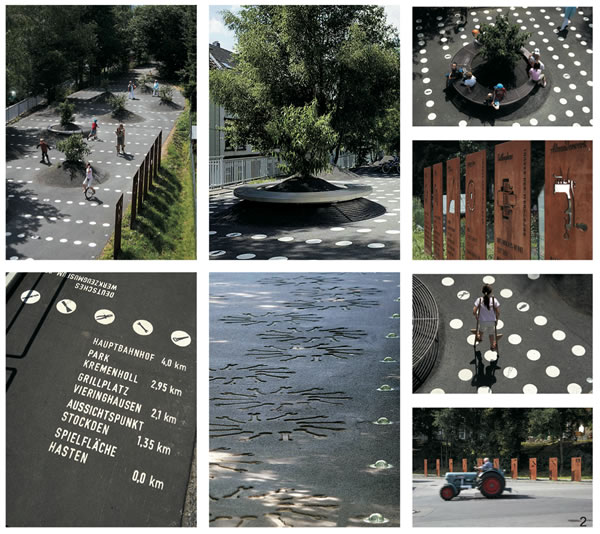
RESEARCH INTENTION
My research intention crystallizes out of the two projects shown. I am interested in how simple form-giving geometries and visual effects such as rotations, mirroring and overlaying of patterns or pixel surfaces can influence our perception of urban space. These type of visual effects, based on simple geometric systems, were especially explored in artworks during the 50ies through to the 70ies by the so called op-art artists. Francois Morellet for instance, explored how concrete geometries can change the perception of space, by turning, mirroring and overlapping simple geometries.
Since my work is apparently and intrinsically connected to op-art and since op-art was constantly and intuitively influencing my work, the starting point of my research will be op-art.
OP-ART: WORKS IN URBAN SPACE
It appears to me that the first step of my ongoing research should be to show the intrinsic connection between the op-art and contemporary art, design & architectural works. Not only do I intend to depict the inherent influence of op-art and especially of the works from Francois Morellet on contemporary works in urban-space, but will also try to record and categorize their questions in order to transfer those into a more contemporary context.
The connection I am trying to reveal will become more evident looking at Francois Morellets translation of 2 dimensional works into the 3 dimensional space. He called this particular translation ,Architectural Disintegrationʻ which closely grasps onto my field of interest.
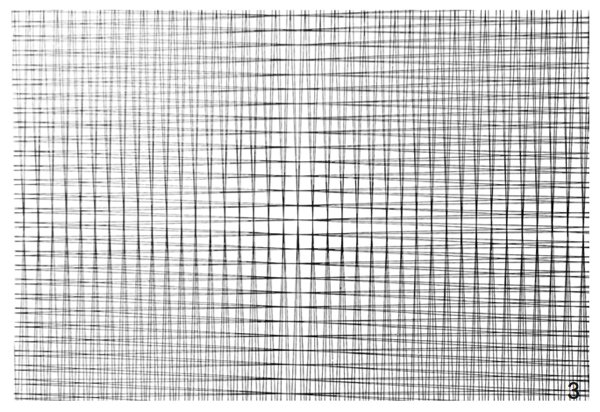
(Francois Morellet)
4 DOUBLES GRIDS -1° +1°, -2° +2° (1961) – KAT. 34
And
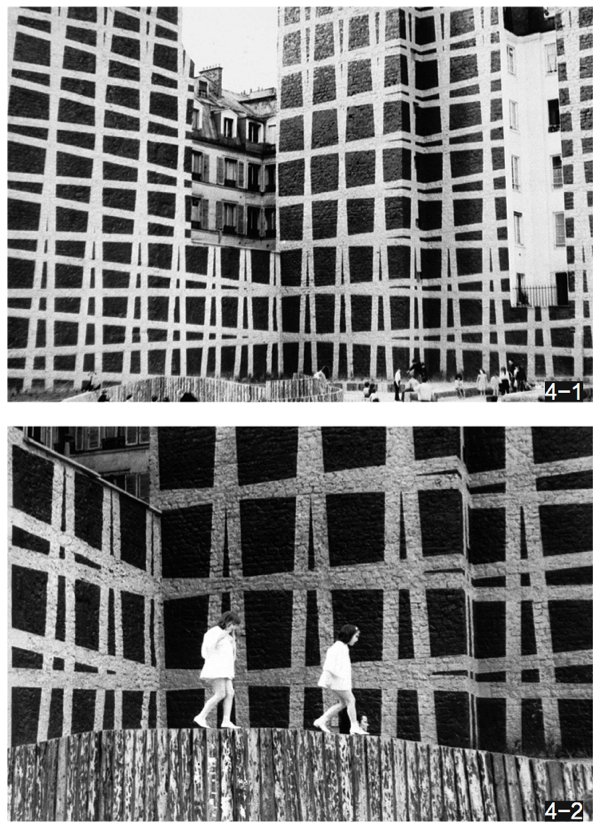
(Francois Morellet)
Integration Archetcturales (he said: architectural disintegration)
GRIDS 3° -87° -93° -83° (1971) location: at the plateau La Reynie, at the junction Quincampoix and Aubry-le-Boucher Nearby the centre pompidou… The work does not exist any longer.
An other good example of this kind of translation (Disintegration) can be seen between his ,dashes with space increaseʻ works and the design for the entrance of the Alpexpo in Grenoble, France:
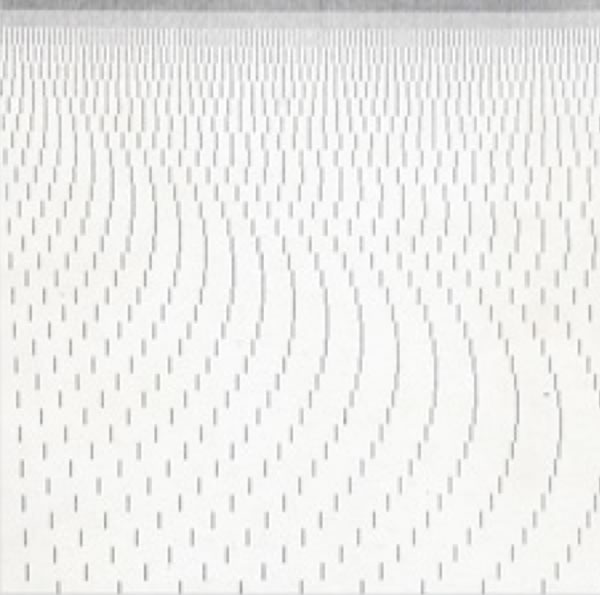
(Francois Morellet)
2 cm dashes with spacing increasing by 2mm every row…
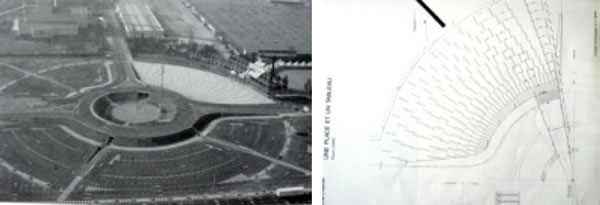
(Francois Morellet & Daniel Jarry)
Daniel Jarry for or with Francois Morellet (A translation into space based on Francois Morelletʻs work – every 1, every 2, every 3….) Location: Alpexpo in Grenoble, France (1988). In a very bad condition.
OP-ART: INFLUENCE IN ART & LANDSCAPE ARCHITECTURE TODAY
The statement, that there is an evident connection between op-art and many contemporary art, design & architecture works appears to be obvious if we look at the art works of Esther Stocker, Christine Rusche and Stephan Ehrenhöfer (see pictures below).
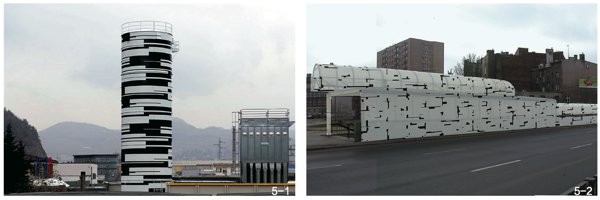
(Esther Stocker)
Silo Barth, 2006, nitro-cellulose lacquer on iron, 15, 7 x 21, 5 m, Brixen / Bressanone, 1974 born in Schlanders, Italien/Italy, LIVING IN AUSTRIA
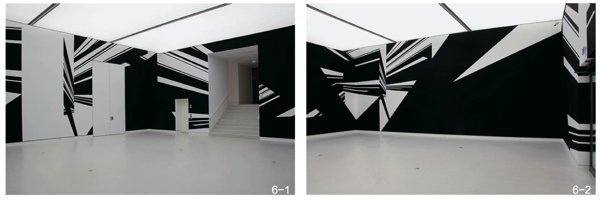
(Christine Rusche)
DEAD RECKONING + site-specific Sonic Space by Kim Laugs (NL) 12,20 m x 12,40 m x 6,30 m, Dispersionsfarbe/acrylic paint,
Kunsthalle Mainz, “Illusion&Konsequenz”, Mainz (Germany), 2008-2009

(Stephan Ehrenhöfer)
Malerei im raum, Dispersion, projektraum Zürich, 1990
APPROACH
The images shown above give you an impression of my ongoing research intention. Now I would like to discuss some obstacles and strategies obtaining a Ph.D and being a designer. Since designers aren`t especially trained in scientific working methods, the next step should be to gain those skills.
The ability to do scientific research foresees that the individual trying to achieve a Ph.D should at least know the ,ownʻ rules or paradigms of his/her discipline. Doing a Ph.D within Design disciplines usually required you to transfer paradigms from other disciplines where those were already set up and were generally accepted. Although you can find several impulses trying to fill this gap, design disciplines haven`t yet set up their own paradigms. Opting to acquire the skills I havenʻt been trained for, I started to educate myself in the classical ways of scientific research, trying to adapt those methods to the needs of my (design) research and confronting unexpected problems while searching for the right methods.
Choosing classical research methods means to restrict my ,designerly skillsʻ, concentrating on very strict paradigms such as defining a precise question, determining the state of research, etc. Overall this would be a more secure way in obtaining a Ph.D.
Choosing to find more suitable research methods for designers such as ,design oriented researchʻ or respectively the so called ,research trough designʻ (RTD) means having to set up possible paradigms for design disciplines, a less secure but more appropriate way.
Since beginning my research I have being jumping back and forward between the classic scientific method and finding more suitable research methods for designers, for instance research through design (RTD).
The search for a validation and personal acceptance, and not merely to achieve a Ph.D through a purely accepted scientific way has taken some time. I have come to the conclusion that it would not make sense to do a Ph.D without having found a more suitable way of researching for designers.
I believe in the symbiotic relation of design and research as source of a creative potential for my work. However, I am convinced that the classic scientific working methods as a base will be helpful in mastering the complexity of the subject. „Defining a precise question, determining the state of research, arranging and evaluating the material, and so forth“ will be and have to be part of my work. Nevertheless, I am looking for broader knowledge through a creative approach to the topic of interest, which means a rather associative but not chronological approach.
My actual design skills can be incorporated into the process through a sort of case-study approach, trying to gain as much information as possible out of my practical work, using my actual work as a generator of information. It is very important to clarify that I am not trying to do research about my design projects.
RELATING RESEARCH TO DESIGN
There are overlapping areas between research and design: While designing we do research, archive, categorize and reflect information. We might not do this using a scientific methodology but rather in an undefined way for very specific tasks. Often the gained information becomes part of future tasks and designs as well.
Linda Groat and David Wang assume that while „design as such is not research as such“, „research can aid the design process in many ways“. In their book „architectural research methods“ they state that „the two domains are equal in intellectual significance“ and claim that „efforts should be made to encourage the view that design activity and research activity are of equal value“.
Questions about the relation between science and design are not only a contemporary phenomena but have already been discussed, for instance, by Immanuel Kant, Richard Neutra, Friedrich Kittler and Rudolf Schindler among others.
According to Kant „aesthetic experiences are part of the domain of reason – even though they can not be fully captured by formulas, words or other determinate modes of communication.“ As explained by Groat and Wang „the entire process of art production is indeterminate, that is, it can not be fully captured by determinate descriptions, and yet it is within the domain of reason.“
Richard Neutra stated in1957 in his book „survival through design“ that „the art of design can associate itself with scientific skill and do so without an inferiority complex“.
HOW CAN DESIGN CONTRIBUTE TO RESEARCH
The main contribution of designers to research consists of preventing science from an auto- implosion caused by the self-referring nature of disciplines as described by Michel Foucault. The renewing vigor of designers and their disciplines appear to be exactly what is most needed. Designers may, for instance, help in identifying and perceiving contemporary research topics and by turning into the eyes of the disciplines that have lost their ability to identify or perceive the most essential contemporary tasks and questions.
REVIEW
Besides the great cultural and academic experience, the serious and constructive exchange and discussions, the Joint Seminar has become a great impulse for my ongoing research. Meeting people in similar situations, emphasizes the significance of how intrinsic joining forces can be. Not only were you able to share these issues and questions with other Ph.D candidates, who are also trying to find a more suitable approach for achieving a Ph.D as designers, but also you got firsthand reviews and observations from professors as well.
>> 点击这里查看本文中文版《几何形体的复杂性——设计师的博士之路》